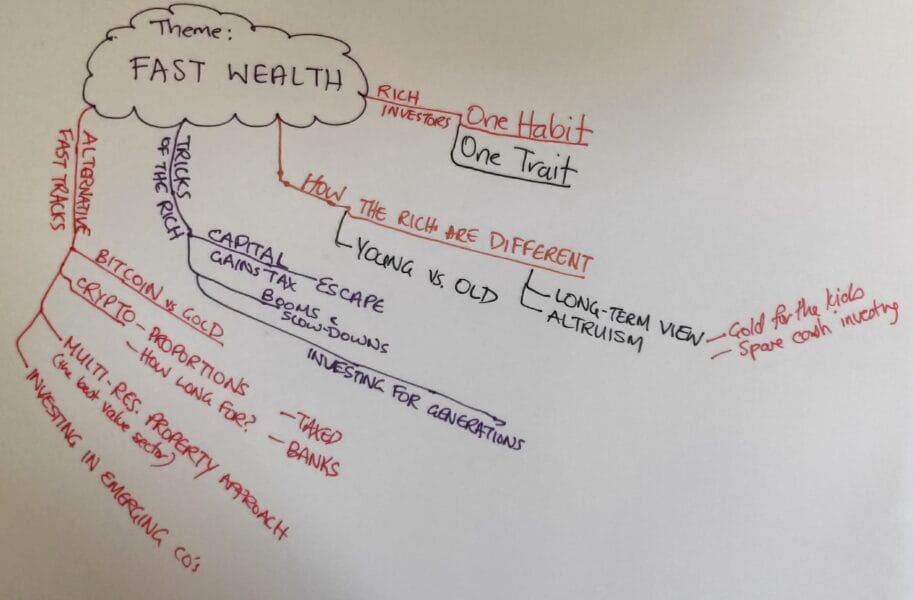You know your field inside out. You’ve helped dozens of clients solve complex problems. You understand what keeps your prospects awake at night.
So why does your online newsletter sit unwritten and unsent?
The usual answer isn’t what most people think. It’s not about writing ability or finding time.
It’s about mind bandwidth.
When financial advisers, consultants, and startup founders come to us stuck on their newsletter or email marketing, they have the expertise. They understand their prospects’ problems. But translating that knowledge into newsletter content exhausts their mental capacity.
The real barrier? They don’t know which ideas actually matter to their audience.
The Research Gap Nobody Talks About
Most newsletter advice says “just share your expertise”. That’s backwards.
Before you write a single word, you need to understand what your audience is actively searching for. Not what you assume they want. What they’re actually typing into Google at 11pm when they’re stuck.
Start with your website analytics. Look at your most popular pages. If you’re ranked on Google, dive into Search Console for the longer keyword phrases people use.
Tools like Answer the Public (Answerthepublic.com) reveal the actual questions your prospects are asking through online search.
Here’s what surprises most people: the content they thought would resonate isn’t what brings readers back. When I analysed my own book publishing blog, I expected insider opinion pieces to dominate. Instead, evergreen how-to articles kept drawing traffic.
Your assumptions about what matters rarely match reality.
Filter For Intent, Not Volume
Here’s where most newsletter creators go wrong. They chase high-volume searches. It’s best to ignore those low-hanging searches.
A financial adviser might find thousands searching for ‘best Super accounts’. But that’s not their angle. Those searchers want comparison charts, not expert guidance.
Instead, filter for expert-seeking intent. Look for searches like “business model expert” or “financial consultant for SaaS”. These signal someone who’s already decided they need qualified help.
Research shows that 39% of advisors don’t create content because they lack time. Fair enough. But the real issue is knowing which content actually moves prospects closer to hiring you. Your team will make the time available.
When you find prospects’ expert-seeking keywords, don’t just answer the surface question… Use it as a springboard.
Uncover The Underlying Struggle
Someone searching “How to grow my SaaS to $500K revenue” isn’t really asking about tactics.
They’re revealing a specific goal. They’re showing you where they’re stuck. Your writing could point out a perspective shift they need to make.
Your newsletter should lift out that underlying struggle and align it with relevant business experience. However, here’s the tension: you need to give genuine, valuable advice whilst creating curiosity about working with you.
The solution? Use metaphor and case stories.
Choose something your audience can quickly relate to. Spectacles work brilliantly for “not seeing things with the same glasses”. Simple. Universal. No over-explanation needed.
For case stories, explain them like you would to a non-industry peer at a dinner party. Natural language. Before and after. No jargon.
Strip Out What Loses Readers
When a financial adviser wants to share a client success story, they typically include everything they think sounds impressive.
That’s exactly what loses readers.
Strip out any mention of products that assume knowledge. Don’t talk about Self-Managed Super Funds to an audience who may not want one. Cut the tax strategy deep-dives that bore readers.
Remove assumptions about what readers already know or want.
Your expertise makes you blind to what’s actually accessible. The ‘dinner party test’ solves this. If you wouldn’t explain it this way to a smart friend over wine, rewrite it.
Newsletters focusing on a specific niche see 16% higher open rates. But that narrow focus only works if you make complex ideas simple, not simpler ideas complex.
When Your Mind Goes Blank
Even with research and a clear angle, you’ll hit creative blocks.
Your analytical brain takes over. You start comparing yourself to professional writers. You overthink every word choice.
Here’s my fix: grab felt pens and paper. Not your laptop or a mapping software. Actual felt pens and blank paper.

Draw a mind map with your narrow topic in the centre. Let branches flow outward without judgment. Studies show that mind mapping boosts information retention by 10-15%, but more importantly, it bypasses your overthinking circuits.
The physical act of drawing activates different neural pathways. Your hand moves faster than your inner critic. Ideas emerge that your analytical mind was blocking.
Don’t overthink it. Just draw.
If the mind map unlocks your structure, move to bullet points for each subtopic. If you’re still stuck, that’s the signal you need a content partner.
What Newsletters are Actually About
After working with financial advisers and consultants as a copywriter, here’s what most get wrong about newsletters.
They think newsletter writing is about giving tax updates or subtle pleas to book a financial plan.
They’re not.
Your newsletter is your chance to show how your advice is nuanced. How your service cares about the person and their success, not just their wallet.
Every newsletter should take a problem or hurdle and offer a simple tip to help with that specific struggle. Not everything. Not a comprehensive solution they can implement alone.
Just enough to demonstrate you see their situation clearly.
When you write this way, the persuasion is subtle. You’re showing prospects what it’s like to work with you. Your thinking process. Your approach to problems. The perspective shift you bring.
That’s what builds trust. That’s what makes someone think, “This person gets it”.
And that’s what turns newsletter readers into clients.
If you’re stuck translating your expertise into newsletter content that resonates, let’s chat. Book a free video call to discover a content strategy that actually works for you.

